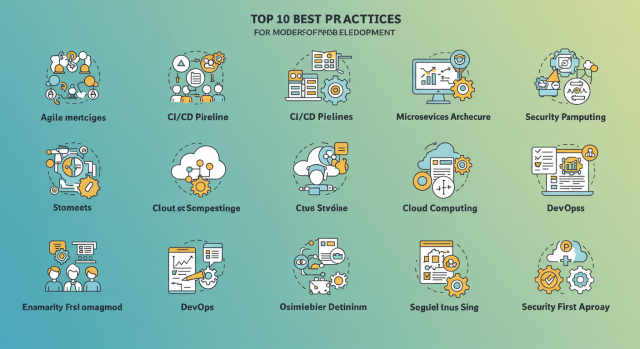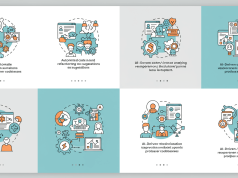The software development landscape is rapidly evolving with new technologies and methodologies emerging at a faster pace than ever before. To keep up with changing user expectations and competitive markets, development teams must embrace a robust set of best practices that enhance productivity, quality, and reliability. In this article, we explore the top 10 best practices for modern software development in 2025. Whether you are a seasoned engineer or part of a growing startup, these guidelines will help you streamline processes, reduce risk, and deliver value to your customers consistently.
Embrace Agile Methodologies

Agile methodologies such as Scrum and Kanban have become the de facto standard for software development teams that value flexibility and rapid delivery. By organizing work into short sprints or continuous flow, teams can respond quickly to changing requirements and gather frequent feedback from stakeholders. Agile encourages cross-functional collaboration, empowers individuals to make decisions, and fosters a culture of continuous improvement through retrospectives and iterative planning. Learn more about
To implement Agile effectively, invest in training, use lightweight project management tools, and establish clear communication channels. Daily standups, sprint planning sessions, and backlog grooming help keep the team aligned on priorities and remove blockers proactively. Remember that Agile is a mindset rather than a rigid process; adapt practices to fit your team’s context and goals.
Implement DevOps and CI/CD
DevOps practices aim to bridge the gap between development and operations teams by promoting collaboration, automation, and shared responsibility. Continuous Integration and Continuous Deployment (CI/CD) pipelines automate the building, testing, and release of code updates, enabling faster and more reliable software delivery. By integrating code changes early and often, you minimize integration issues and ensure that deployments are repeatable.
Set up automated build servers that run unit tests, integration tests, and static analysis on every commit. Define clear deployment pipelines that include staging and production environments, and use feature flags to control rollouts. Embrace infrastructure as code tools like Terraform or Ansible to provision environments consistently. A mature DevOps culture accelerates time to market while reducing manual errors and operational risks.
Prioritize Code Quality and Testing
Maintaining high code quality is essential for the long-term health and sustainability of any software project. Adopt coding standards and style guides that enforce consistency across the codebase. Use linters and static analysis tools to catch bugs, security vulnerabilities, and code smells early in the development cycle. Consistent code reviews ensure that best practices are followed and knowledge is shared within the team.
Invest in comprehensive testing strategies that include unit tests, integration tests, and end-to-end tests. Aim for sufficient test coverage, but prioritize meaningful tests that validate critical functionality. Automated testing reduces the risk of regressions and makes refactoring safer. Regularly review and update tests to match evolving requirements and remove obsolete scenarios.
Automate Testing and Quality Assurance
Automation plays a pivotal role in enhancing efficiency and reliability in software development. Beyond unit and integration tests, extend automation to UI testing, performance testing, and security scanning. Tools like Selenium, Cypress, and JMeter help simulate user interactions and load conditions in a repeatable manner. Continuous testing within the CI/CD pipeline provides immediate feedback on code changes and accelerates release cycles.
Incorporate security scanning tools such as OWASP ZAP or Snyk to detect vulnerabilities in dependencies and application code. Automate database migration tests to prevent data integrity issues during deployments. By building a robust test automation framework, teams can detect defects earlier, reduce manual effort, and focus on delivering new features with confidence.
Conduct Regular Code Reviews and Pair Programming
Code reviews are a cornerstone of collaborative software development and serve multiple purposes: improving code quality, identifying bugs, and sharing domain knowledge. Establish a lightweight pull request workflow with clear guidelines on review scope and turnaround time. Encourage constructive feedback and focus on solving problems rather than assigning blame.
Pair programming complements code reviews by allowing two developers to work on the same piece of code simultaneously. This practice enhances knowledge transfer, reduces the time spent on debugging, and fosters team cohesion. Even occasional pairing sessions can lead to better design decisions and a deeper understanding of complex components.
Adopt Continuous Integration and Deployment Strategies
While CI/CD was mentioned in the context of DevOps, it deserves its own spotlight given its impact on software delivery. Continuous Integration ensures that every code change is integrated and tested frequently, while Continuous Deployment automates the release process so that code can be delivered to end users without manual intervention. These strategies significantly reduce lead times and improve feedback loops.
Implement monitoring and rollback mechanisms to handle failed deployments gracefully. Use blue-green or canary deployment patterns to minimize user impact during releases. By automating the full pipeline from code commit to production release, teams can deliver features faster, with fewer errors, and maintain a high degree of operational stability.
Design for Scalability and Modularity
Software systems must be designed to accommodate growth in user base, data volume, and feature complexity. Adopt modular architectures such as microservices or service-oriented design to decouple components and enable independent development and deployment. This approach facilitates parallel workstreams, improves fault isolation, and simplifies scaling specific services based on demand.
Use domain-driven design principles to define clear service boundaries and leverage API gateways for communication. Implement asynchronous messaging and event-driven patterns to handle peak loads and maintain responsiveness. Designing for scalability from the outset prevents costly rework and performance bottlenecks as applications evolve.
Monitor, Observe, and Optimize in Production
Effective monitoring and observability are crucial for maintaining system health and quickly diagnosing issues in production. Instrument applications with logging, metrics, and distributed tracing to gain insights into user behavior, performance bottlenecks, and error conditions. Tools like Prometheus, Grafana, and Jaeger enable real-time visibility into system metrics and service dependencies.
Set up automated alerts for key performance indicators and error thresholds. Conduct regular incident reviews and postmortems to identify root causes and implement preventive measures. Continuous optimization based on real-world usage data helps improve reliability, reduce downtime, and deliver a better user experience.
Implement Security by Design
Security must be integrated into every phase of the software development lifecycle rather than tacked on as an afterthought. Adopt threat modeling practices to identify potential attack vectors early and define security requirements accordingly. Use secure coding guidelines and conduct regular security reviews to enforce best practices.
Incorporate security testing into the CI/CD pipeline, including static application security testing (SAST) and dynamic application security testing (DAST). Manage secrets and credentials securely using vault solutions. Regularly update dependencies to address known vulnerabilities. A proactive security posture reduces the risk of data breaches and builds trust with users.
Prioritize Documentation and Knowledge Sharing

Clear documentation is vital for onboarding new team members, maintaining institutional knowledge, and ensuring smooth collaboration. Maintain up-to-date API documentation, architecture diagrams, and coding guidelines in a centralized repository. Use tools like Swagger or Just the Docs to generate interactive documentation for developers and stakeholders.
Encourage regular knowledge-sharing sessions, such as lunch and learns or brown-bag seminars, to disseminate best practices, lessons learned, and emerging technologies. Foster a culture of learning by rewarding contributions to documentation and internal wiki pages. Well-documented systems accelerate development velocity and reduce the risk of knowledge loss when team members transition out.
Conclusion
Modern software development demands a holistic approach that combines technical excellence, collaboration, automation, and security. By embracing agile methodologies, implementing DevOps and CI/CD, prioritizing code quality and security, and fostering a culture of continuous improvement, teams can deliver high-quality software at speed and scale. Apply these 10 best practices in your next project to accelerate delivery, improve reliability, and delight your users.








